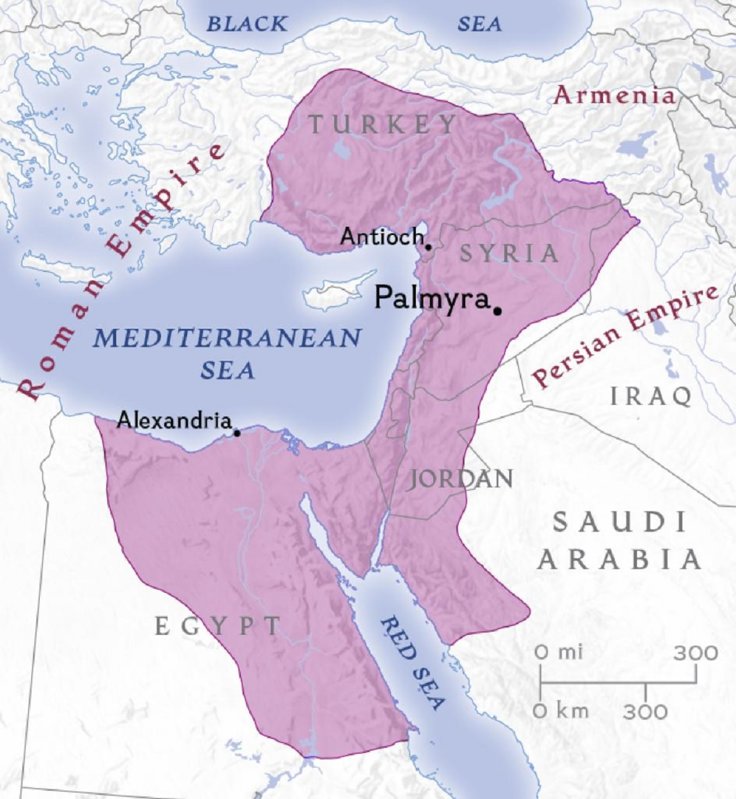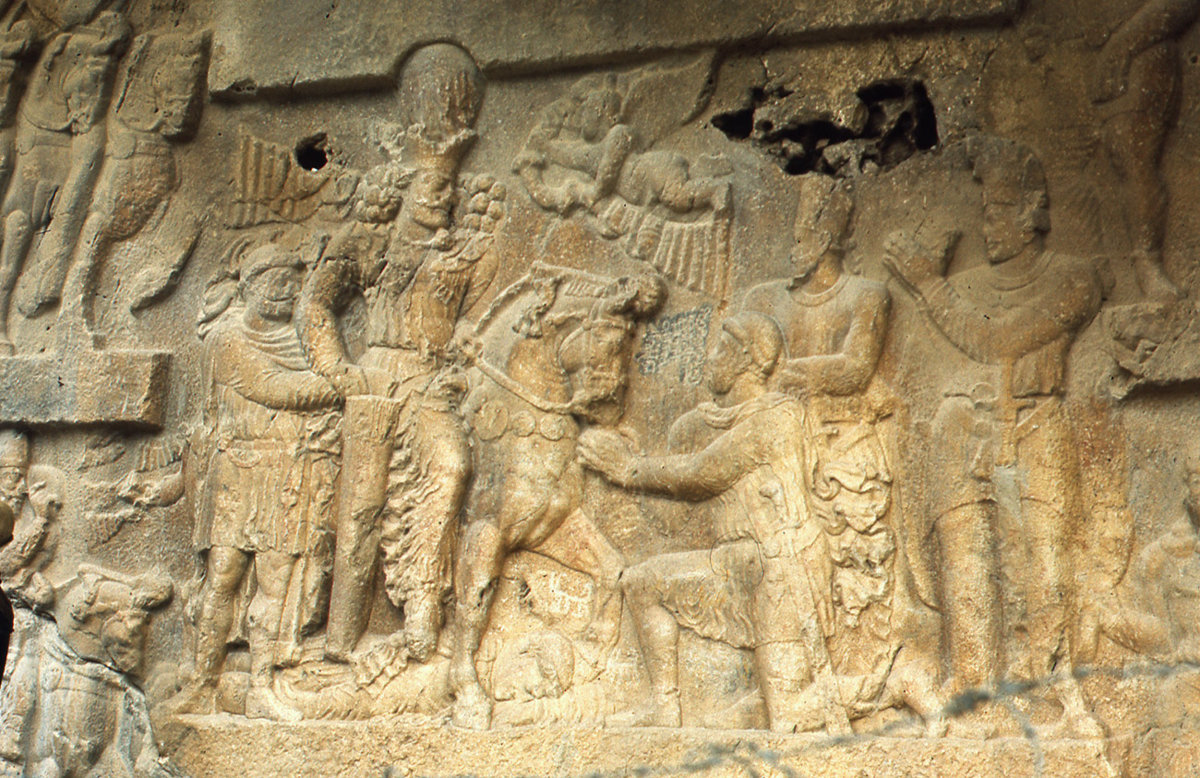ZENOBIA (240-275) A QUEEN OF THE PALMYRENE EMPIRE IN SYRIA WHO CHALLENGED THE AUTHORITY OF THE ROMAN EMPIRE IN THE 3TH CENTURY.SHE CONQUERED EGYPT,ANATOLIA,LEBANON AN ROMAN JUDEA UNTIL FINALLY BEING DEFEATED BY ROMAN EMPEROR AURELIAN .
 Zenobia was a tenacious leader and tactician who challenged the Roman Empire.A native of Syria, Zenobia was born long after her homeland had been made a Roman province. Unfortunately for Zenobia, her luck went south in 272 CE when a Roman general, Aurelian, succeeded in becoming Emperor. A career military man who had started as a simple foot soldier, Aurelian ended the political power struggle which had kept Rome from focusing on Zenobia's insurrection.
Zenobia was a tenacious leader and tactician who challenged the Roman Empire.A native of Syria, Zenobia was born long after her homeland had been made a Roman province. Unfortunately for Zenobia, her luck went south in 272 CE when a Roman general, Aurelian, succeeded in becoming Emperor. A career military man who had started as a simple foot soldier, Aurelian ended the political power struggle which had kept Rome from focusing on Zenobia's insurrection.
Zenobia was a tenacious leader and tactician who challenged the Roman Empire.A native of Syria, Zenobia was born long after her homeland had been made a Roman province. Well educated in classical philosophy, she spoke at least four languages and at an early age was placed in charge of her rich family's estates and cattle herds.In 258 CE she married a Roman Senator who went on to become the Governor of Syria. Though she had at least one son with him and several daughters the marriage may not have been a happy one as Zenobia refrained from sleeping with her husband except when they wanted children.Six years after their marriage, her husband and his eldest son from another wife were murdered by a nephew. Since her son was still a minor, Zenobia took over as regent of Syria on his behalf.Situated on a profitable trade route and inheriting a large army from her late husband, Zenobia was well placed to break with Rome.Desiring greater independence for herself and encouraged by ambitious courtiers and philosophers at her capital, Palmyra, Zenobia decided to throw off Roman rule and create her own Empire. With Rome gridlocked in a power struggle over who would be the next Emperor, Zenobia was free invade Roman Egypt with her armies. Initially unsuccessful, her soldiers drew the Romans north into Syria where they were annihilated on her home turf.With Egypt and Syria under her control, Zenobia continued her aggressive expansion adding modern day Palestine, Jordan and parts of Turkey to her Empire taking away almost a third of Rome's territories.The power dwelled in the city of Palmyra in the third century A.D. This cosmopolitan capital of the Roman province of the same name lay close to the empire’s eastern borders, providing the setting for Queen Zenobia’s ambitious power play.This ancient queen of Palmyra conquered Egypt, captured Roman provinces, and nearly transformed her realm into an empire equal to Rome.The showdown had been decades in the making. By the middle of the third century A.D. the Roman Empire was mired in political and economic crisis, its frontiers under constant attack, and its center struggling to hold. The catastrophic defeat and capture in 260 of Emperor Valerian by the Persians thrust Roman rule into even greater disarray. In Europe the rebel Gallic empire started to break away from Rome. Weakened and distracted, the empire was facing threats on all fronts. Observing from the east, Zenobia saw her opportunity and knew that she had an empire to gain.Palmyra had a history of cooperation with Roman rule, and this had resulted in many benefits for the desert kingdom. Located in the middle of modern-day Syria, around 130 miles northeast of Damascus, Palmyra had prospered since coming under Roman control in the first century A.D. Sitting at the crossroads between the Mediterranean world ruled by Rome and the great empires of Asia, it became a center of huge strategic and economic importance.An obligatory stopover for the caravans that traversed the deserts, the wealth flooding into Palmyra gave its rulers the means to beautify their city, as well as the confidence to assert themselves regionally. Known as the “pearl of the desert,” the oasis city was famed for its magnificent buildings, such as its Arch of Triumph and an impressive theater. By the middle of the third century the Palmyrene empire was already enjoying a certain independence albeit as a client state within the Roman Empire. Zenobia sought to change that.Over the centuries, Zenobia’s life story has been subjected to a great deal of scholarly speculation. The colorful but unreliable Augustan History, a late Roman collection of biographies, states that Zenobia associated herself with the Ptolemies of Egypt, including Cleopatra. Eastern historians, such as the ninth-century Persian al-Tabari, believed that Zenobia was not Greek but of Arab descent. Modern historians agree that the queen of Palmyra did not descend from the Ptolemies and most likely came from an influential Palmyrene family in which she had been well educated.Zenobia married Odaenathus, a Romanized Arab and ruler of Palmyra. Reigning from 263, Odaenathus successfully defended Palmyra from the Persians, who were riding high after their humiliating defeat of Emperor Valerian. Remaining loyal to Rome outwardly at least Odaenathus managed to break through the Persian lines and force them to retreat to Persian territory.
 Zenobia, Visionary Queen of Ancient Palmyra.She was “ambitious” as if male aspirants to the Empire were not ambitious suggesting, too, that she was scheming and foolish or imprudent. Yet why did so many men take the huge risk of rebellion on her behalf? Surely not to satisfy a woman’s frivolous dreams. No one even considers that she might have been right: the Romans could no longer defend the East.
Zenobia, Visionary Queen of Ancient Palmyra.She was “ambitious” as if male aspirants to the Empire were not ambitious suggesting, too, that she was scheming and foolish or imprudent. Yet why did so many men take the huge risk of rebellion on her behalf? Surely not to satisfy a woman’s frivolous dreams. No one even considers that she might have been right: the Romans could no longer defend the East.
From the outset, Odaenathus claimed to be acting on Rome’s behalf, but it soon became clear that he wanted to establish himself as “monarch of the East.” Given Rome’s tenuous position, the new emperor Valerian’s son, Gallienus had little choice but to acknowledge the powerful status of Odaenathus. Already boasting several titles awarded by Rome, including corrector totius Orientis (governor of the entire East), Odaenathus was also crowned “king of kings” by his own people. Palmyra might have become the capital of a new empire, but it was not to be. Odaenathus’s ambitions were thwarted by a palace intrigue in 267. On returning from a campaign against the Goths in Cappadocia (central Turkey), a relative murdered him in his palace.Zenobia’s moment had arrived. Her son by Odaenathus, Wahballat (Vaballathus in Latin) was the heir, but still a child. Zenobia declared herself regent, a move that allowed her to seize control of territories in the east, recently taken from the Persians. She executed the parties responsible for her husband’s death, and then set to end the fiction that Palmyra and its domains were submissive to the Roman Empire and its emperor. Zenobia knew how to take advantage of the Roman Empire’s moment of weakness. She scorned Emperor Gallienus and his generals, who were powerless to stop her. When the next, short-lived Roman emperor, Claudius Gothicus, acceded, he had no choice but to recognize her sovereignty. Zenobia had achieved her aim: to make Palmyra an equal to Rome.Little by little, with astuteness and the wise advice of her counselors, Zenobia widened the break with Rome. Keeping the Persians at bay to the east, she annexed various neighboring states, including all of Syria and most of Anatolia (modern-day Turkey). In 269 she sent her forces into Egypt and seized Alexandria. By 270 she had taken control of all of Egypt, its wealth, and the grain it supplied to Rome. Her empire looked unstoppable.Rome’s next emperor of consequence, Lucius Domitius Aurelianus, was a very different kind of adversary. Taking power in 270, Aurelian possessed a rigid military discipline forged in battle on the imperial frontiers. His ferocity on the front line was legendary, giving rise to a verse of a song in Latin: “Mille, mille, mille occidit!—A thousand, a thousand, a thousand he’s killed!” During the four brief years of his reign, this hardened soldier won his predecessors’ war with the Goths, repelled a barbarian invasion of northern Italy, and restored Roman rule in the unruly provinces of Gaul, Britannia, and Hispania.Zenobia’s growing power and open defiance of Roman authority, especially following the declaration of her own son as Caesar in 271, could not help but attract Aurelian’s attention. The challenge she presented far exceeded that of a male ruler gone rogue: “Now all shame is exhausted,” the Augustan History lamented, “for in the weakened state of the Roman commonwealth things came to such a pass that . . . a foreigner, Zenobia by name proceeded to cast about her shoulders the imperial mantle and ruled longer than could be endured from one of the female sex.”Aurelian retaliated, taking back territory from Zenobia as his legions advanced through Asia Minor. Near Antioch, her army of 70,000 men made a stand, but after Aurelian’s forces defeated them, the remaining soldiers retreated to Palmyra. Aurelian’s legions pursued them and arrived at the city walls in 272.They laid siege to Palmyra, but Zenobia was confident that her archers and cavalry could repel them. If that did not work, perhaps the Romans would succumb to hunger and the merciless desert climate. According to the Augustan History, the queen fired off a message full of characteristic defiance: “From Zenobia, Queen of the East, to Aurelian Augustus . You demand my surrender as though you were not aware that Cleopatra preferred to die a queen rather than remain alive, however high her rank.”Stung by this rebuff from a woman, Aurelian redoubled his efforts to take the city. In desperation, the queen tried to flee eastward to Persia but was captured the Augustan History relates—when she reached the Euphrates River. The city soon surrendered.Much like her birth, the exact circumstances of Zenobia’s death are uncertain. Some Arab sources say that she committed suicide to avoid capture. Roman sources claim that Aurelian, unwilling to put a woman to death, brought her as a captive to Rome. The queen, it was said, had always longed to visit Rome, “and this hope was not unfulfilled,” the Augustan History recorded with irony: “for she did, indeed, enter the city but vanquished and led in triumph.” Some sources claim she was decapitated there. Others recount that she married a Roman senator and lived out her life as a Roman matron. Whatever befell her, Zenobia has captured the imagination of generations of writers, enthralled by the exploits of this powerful queen who defied Rome.Rome was corrupt. They had debased the currency; inflation was rampant; taxes had reached confiscatory levels. Emperor after emperor was murdered, unleashing civil wars as ambitious generals fought against each other, rather than against the common Persian enemy. Aurelian, who defeated her in 272 A.D., leaving a ruined Palmyra in his wake, cobbled the Empire back together, but none of the underlying problems were solved (and three years later, he too was murdered). Twenty years later, the Empire was being ruled by four Emperors; sixty years later, Constantine established his capital at Byzantium and it split into East and West.
 Queen Zenobia coins would be taken as a legendary figure. There could be a kernel of truth in the story, but it is a tale so fantastical, so gendered, with sources so unreliable, that it simply could not have historical value. Yet Zenobia did exist, and she did go to war against the Romans. And, as Empress of the East, she came within a hair’s breadth of victory.
Queen Zenobia coins would be taken as a legendary figure. There could be a kernel of truth in the story, but it is a tale so fantastical, so gendered, with sources so unreliable, that it simply could not have historical value. Yet Zenobia did exist, and she did go to war against the Romans. And, as Empress of the East, she came within a hair’s breadth of victory.
 In any case, it can’t have been much fun being ruler of an eastern outpost of Rome just when the Romans were reeling from defeat after defeat delivered by the new Persian Empire across the Euphrates River. In 253 A.D., the Persians attacked Syria and looted Antioch, the greatest city of the East. Three years later, Dura Europos fell, the river stronghold garrisoned by Roman and Palmyran troops. Now nothing but empty steppe stood between the enemy and Palmyra itself, the richest surviving city of Syria.
In any case, it can’t have been much fun being ruler of an eastern outpost of Rome just when the Romans were reeling from defeat after defeat delivered by the new Persian Empire across the Euphrates River. In 253 A.D., the Persians attacked Syria and looted Antioch, the greatest city of the East. Three years later, Dura Europos fell, the river stronghold garrisoned by Roman and Palmyran troops. Now nothing but empty steppe stood between the enemy and Palmyra itself, the richest surviving city of Syria.

